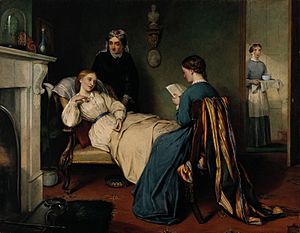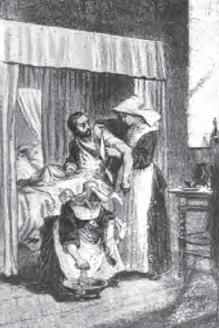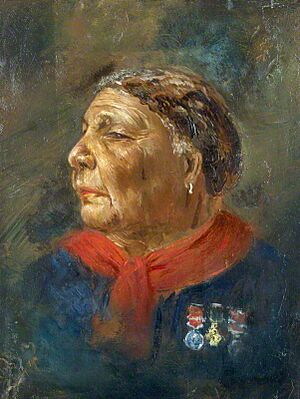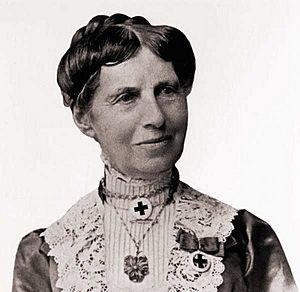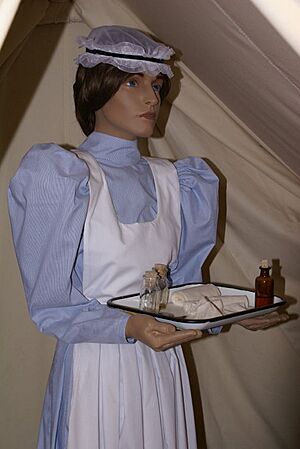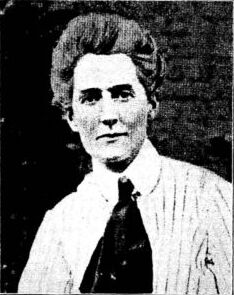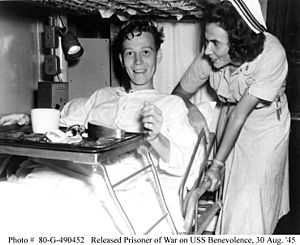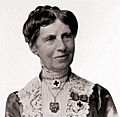Timeline of nursing history facts for kids
Contents
Nursing is a very old and important job. It's all about taking care of people who are sick, hurt, or need help to stay healthy. Nurses help people feel better and get well. Over many centuries, nursing has changed a lot, from simple care given by religious groups to the highly trained profession we see today. Let's explore how nursing has grown through history.
Early Days of Nursing (Before the 16th Century)
In ancient times, nursing was often done by religious groups. They helped people who were sick and their families.
- Around 55 AD – A woman named Phoebe is known as one of the first Christian nurses. She was a deaconess, a helper in the church.
- Around 300 AD – Christian women started to become more involved in nursing.
- Around 390 AD – The first general hospital was opened in Rome by Saint Fabiola. This was a big step for organized care.
- Around 620 AD – Rufaidah bint Sa'ad became the first Muslim nurse, showing that nursing was important in different cultures.
Changes in the 16th and 17th Centuries
Big changes in Europe affected nursing.
- 1517 – The Protestant Reformation led to many religious groups closing their hospitals. This meant fewer places for people to get nursing care in some areas.
- 1633 – Vincent de Paul and Louise de Marillac started the Daughters of Charity of Saint Vincent de Paul. These nurses didn't stay in convents. Instead, they went into people's homes to care for the poor. They believed their "monastery" was the homes of the sick.
- 1645 – A French nurse named Jeanne Mance opened Hôtel-Dieu de Montréal, which was North America's very first hospital.
- 1654–1656 – The Sisters of Charity also helped wounded soldiers on battlefields in France.
Nursing in the 18th Century
The 18th century was called the Age of Reason. People started to use science to understand the world better.
- In Jamaica, women known as "doctresses" like Cubah Cornwallis and Grace Donne were very good at healing. They used good hygiene and natural herbs to help the sick.
Important Nurses of the 19th Century
The 19th century brought many famous nurses and big changes.
- 1820 – Florence Nightingale was born. She would become known as the founder of modern nursing.
- 1850 – Florence Nightingale began her nursing training in Egypt.
- 1851 – She finished her training in Germany. Her teachers said she was a trained nurse.
- 1853 – Florence Nightingale went to Paris to study more. She was later put in charge of English hospitals in Turkey.
- 1805 – Mary Seacole was born in Jamaica. Her mother was a skilled healer who used herbs and good hygiene.
- 1851 – Mary Seacole traveled to Panama and helped people with diseases like cholera.
- 1855 – During the Crimean War, Mary Seacole went to Crimea. She set up a "British Hotel" to care for wounded British soldiers. She used herbs and kept things very clean, which helped many soldiers.
New Hospitals and Training Schools
- 1838 – The first trained nurses arrived in Sydney, Australia. They were five Irish Sisters of Charity.
- 1844 – Dorothea Dix spoke up for people with mental illness in New Jersey. She helped improve their treatment.
- 1859 – Florence Nightingale wrote her famous book, "Notes on Nursing." Her ideas from this book became the basis for how nurses should practice.
- 1860 – The Nightingale Training School for nurses was started in London. This school set the standard for modern nursing education.
- 1861–1865 – During the American Civil War, many women served as army nurses.
- 1863 – The International Red Cross was created in Switzerland. This group helps people in wars and disasters.
- 1873 – Linda Richards became America's first officially trained nurse.
- 1873 – The first nursing school in the United States, based on Florence Nightingale's ideas, opened at Bellevue Hospital in New York City.
- 1879 – Mary Eliza Mahoney became the first black professional nurse in the U.S.
- 1881 – Clara Barton founded the American Red Cross and became its first president.
- 1891 – The Cape Colony (in South Africa) was the first place in the British Empire to officially register nurses.
- 1893 – Lillian Wald started teaching nursing classes to women in New York City's Lower East Side. She later founded the Visiting Nurse Service of New York.
- 1893 – The Nightingale Pledge was first used by graduating nurses. It's like a promise nurses make to care for patients.
- 1899 – The International Council of Nurses was formed. This group connects nurses from all over the world.
Nursing in the 20th Century
The 20th century saw nursing become a highly respected and regulated profession.
- 1901 – New Zealand became the first country to have a national law for registering nurses. This meant nurses had to meet certain standards.
- 1902 – Ellen Dougherty of New Zealand became the world's first registered nurse.
- 1902 – Lina Rogers Struthers was hired as North America's first school nurse in New York City.
- 1908 – The United States Navy Nurse Corps was created.
- 1909 – The University of Minnesota School of Nursing offered the first bachelor's degree in nursing. This raised the bar for nurse training.
- 1910 – Florence Nightingale passed away at age 90.
- 1914 – Nurses from New Zealand, Britain, Australia, America, and Canada worked together in World War I.
- 1915 – Edith Cavell, a British nurse, was executed by a German firing squad for helping Allied soldiers escape during the war. She is remembered as a hero.
- 1919 – The UK passed a law for nurse registration, making nursing a more formal profession.
Growth and Specialization
- 1922 – The Filipino Nurses Association was founded, later becoming the Philippine Nurses Association.
- 1923 – Yale School of Nursing became the first nursing school to base its teaching on an educational plan, not just hospital needs.
- 1923 – Mary Carson Breckinridge founded the Frontier Nursing Service in Kentucky, bringing healthcare to rural areas.
- 1939–1945 – During World War II, many military and naval nurses served their countries, often overseas.
- 1942 – A terrible event happened on Banka Island. Twenty-one Australian nurses who survived a sunken ship were killed by Japanese soldiers.
- 1948 – The National Health Service (NHS) was launched in the UK, providing healthcare for everyone.
- 1951 – Men were allowed to join the same nurse register as women in the United Kingdom for the first time.
- 1952 – New medicines called sedatives changed mental health nursing, making it easier to care for patients.
- 1953 – The National Student Nurses' Association was created for nursing students.
- 1960 – The first Neonatal Intensive Care Unit (NICU) was set up to care for very sick newborn babies.
- 1965 – The first nurse practitioner (NP) role was created. Nurse practitioners are nurses with advanced training who can do many things doctors do.
- 1967 – The first hospice was set up in London. Hospices provide comfort and care for people who are very ill.
- 1967 – Nursing education in New Zealand started moving from hospital-based training to universities and colleges.
Modern Nursing
- 1971 – A report in New Zealand suggested training nurses in educational settings like polytechnics, not just hospitals.
- 1976 – The first master's degree program in nursing for a historically Black College or University was founded at Hampton University.
- 1980 – The Roper, Logan and Tierney model of nursing was published. It focuses on how nurses can help people with their daily activities.
- 1983 – The International Council of Nurses emphasized the importance of human rights in nursing.
- 1984 – Australia decided that all nurses should get their education at universities or colleges.
- 1992 – Eddie Bernice Johnson became the first nurse elected to the U.S. Congress.
- 1999 – The first doctoral degree program in nursing for a Historically Black College or University was founded at Hampton University.
Nursing in the 21st Century
Nursing continues to evolve with new technologies and healthcare needs.
- 2002 – The Nursing and Midwifery Council took over as the main group regulating nurses in the UK.
- 2004 – The American Association of Colleges of Nursing suggested that all advanced practice nurses should earn a Doctor of Nursing Practice degree.
- 2004 – The Nursing License Compact began in the U.S., allowing nurses licensed in one state to work in other states that are part of the compact.
- 2010 – A national registration for all nurses and midwives started in Australia.
Images for kids


